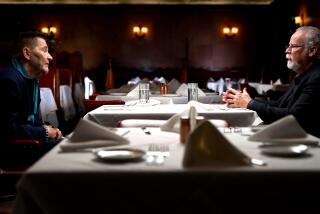KING CASE AFTERMATH: A CITY IN CRISIS : TELEVISION : Medium’s Influence Sometimes Warps Our Sense of Reality
- Share via
Linda Mour, a reporter for KABC-TV Channel 7, had just covered another episode of looting in South Los Angeles. And now she was in the studio, being debriefed live by anchor Harold Greene about the videotaped chaos being telecast. On the screen were loot-laden pillagers of all ages, many of them appearing to be Latino, with Mour pursuing several and demanding to know why they were breaking the law.
Time for analysis.
“Did you get the impression,” asked Greene, “that a lot of those people were illegal aliens?”
“Yes,” Mour replied.
Time for a double take.
Perhaps Mour was able to identify them as illegal because some of the looters had that stamped on their foreheads. Or--a much better bet--perhaps both she and Greene were predisposed to believe that illegal immigrants automatically commit crimes.
If so, their predisposition was transmitted across the airwaves as fact.
This television moment speaks to the danger of mind-sets.
Take the Rodney G. King jurors, who have begun speaking out anonymously on television, reacting to the violence that has shaken Los Angeles and explaining their verdicts that resulted in mass arson and looting.
We’ve heard what’s on their tongues, but not what’s in their minds, deep in their minds.
Bob Kholos is thinking about that. Now a Eugene, Ore. resident, Kholos was Mayor Tom Bradley’s first press secretary, from 1973 to 1975. He called Friday with a theory about those explosive verdicts resulting from a Simi Valley trial featuring an oft-played videotape showing African-American King, seemingly helpless on the ground, being beaten by white Los Angeles police officers who were seeking to arrest him after a high-speed car chase.
“It’s television,” said Kholos, describing the alleged mind-set of the jurors.
Television?
“Yes. They’ve seen Archie Bunker tell them it’s all right to be a bigot. They’ve seen ‘The Cosby Show,’ which is about a wealthy black doctor. They’ve seen all these black athletes on television making million-dollar salaries. That’s their reality. Their unreality is real life.”
Real life? “The beating of King.”
Well, it’s one man’s compelling theory about TV’s hermetically sealed cocoon. Moreover, Kholos also could have mentioned Oprah Winfrey, Arsenio Hall and the fictional characters of “The Jeffersons” as narrowly representative African-American figures whose steady TV presences have given the impression that they reflect the norm.
Supporters of the verdicts would argue, conversely, that it was the famous videotape shot by amateur camcorder operator George Holliday that produced the unreality.
Regardless of that, there’s no dodging the reality of television’s influence on our lives, and rarely more so than during coverage of the King trial and its turbulent aftermath. It’s been a time when words and visual images have created their own powerful commentaries.
After King’s televised plea for calm on Friday, the subsequent analysis from some local anchors consisted of Rodney this and Rodney that, the repeated use of his first name tending to infantilize this hulking man. Although surely unintentional, the message was a subliminal denigration of African-Americans. After all, were any of the four police officers ever referred to by anchors only by their first names?
The TV coverage has fed another misconception, meanwhile. In almost exclusively focusing on African-Americans’ disapproval of the King verdicts, TV has authored an us versus them scenario, making it appear that whites universally applauded the trial’s outcome.
When it comes to shaping public opinion, one also wonders about the TV coverage of a besieged Los Angeles appearing elsewhere in the nation. Kholos reports that nearly all the TV footage he’s seen in Eugene shows “the burning and the young kids looting.”
Pictures of perpetrators running uncontrolled through smoky ruins? The circle is complete, as America watches images that feed the very “Gorillas in the Mist” prejudice that many believe motivated the King incident in the first place.
More to Read
Sign up for Essential California
The most important California stories and recommendations in your inbox every morning.
You may occasionally receive promotional content from the Los Angeles Times.




![Vista, California-Apri 2, 2025-Hours after undergoing dental surgery a 9-year-old girl was found unresponsive in her home, officials are investigating what caused her death. On March 18, Silvanna Moreno was placed under anesthesia for a dental surgery at Dreamtime Dentistry, a dental facility that "strive[s] to be the premier office for sedation dentistry in Vitsa, CA. (Google Maps)](https://ca-times.brightspotcdn.com/dims4/default/07a58b2/2147483647/strip/true/crop/2016x1344+29+0/resize/840x560!/quality/75/?url=https%3A%2F%2Fcalifornia-times-brightspot.s3.amazonaws.com%2F78%2Ffd%2F9bbf9b62489fa209f9c67df2e472%2Fla-me-dreamtime-dentist-01.jpg)








